Principles of Sustainability: Melbourne Climate Change Report
VerifiedAdded on 2023/06/07
|11
|2692
|150
Report
AI Summary
This report provides a comprehensive analysis of climate change impacts on Melbourne, Australia. It examines changes in precipitation, sea level, humidity, wind, and temperature, and discusses the social impacts of these changes, including water and food supplies and refugee movements. The report references the Climate Change Adaptation Strategy Refresh 2017 and explores climate change projections for 2030, 2050, and 2100, highlighting the severity of the expected conditions. Furthermore, it covers various climate change adaptation strategies and their effectiveness. The report concludes with an overview of the discussed factors and emphasizes the importance of considering climate change for Melbourne's future.
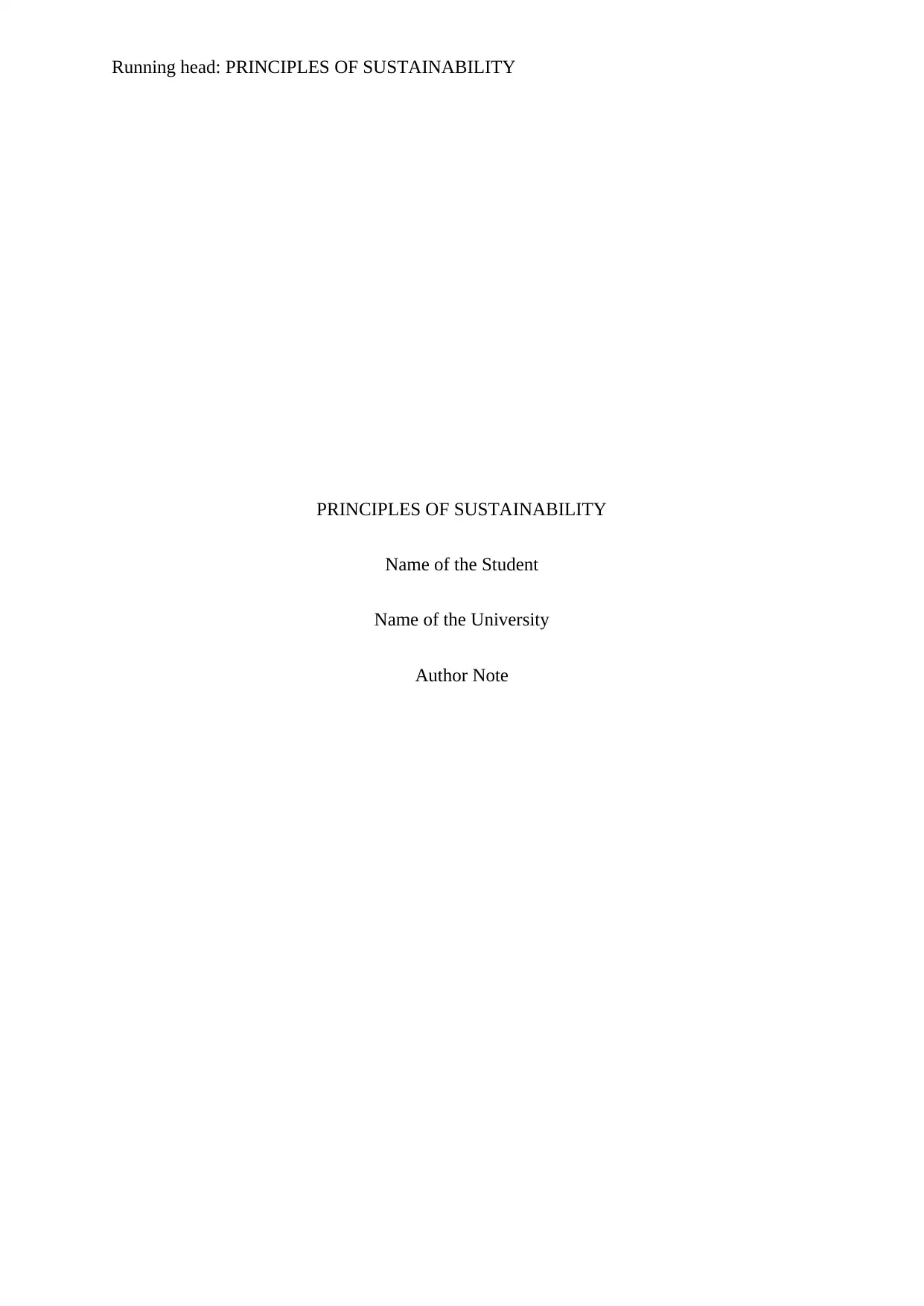
Running head: PRINCIPLES OF SUSTAINABILITY
PRINCIPLES OF SUSTAINABILITY
Name of the Student
Name of the University
Author Note
PRINCIPLES OF SUSTAINABILITY
Name of the Student
Name of the University
Author Note
Paraphrase This Document
Need a fresh take? Get an instant paraphrase of this document with our AI Paraphraser
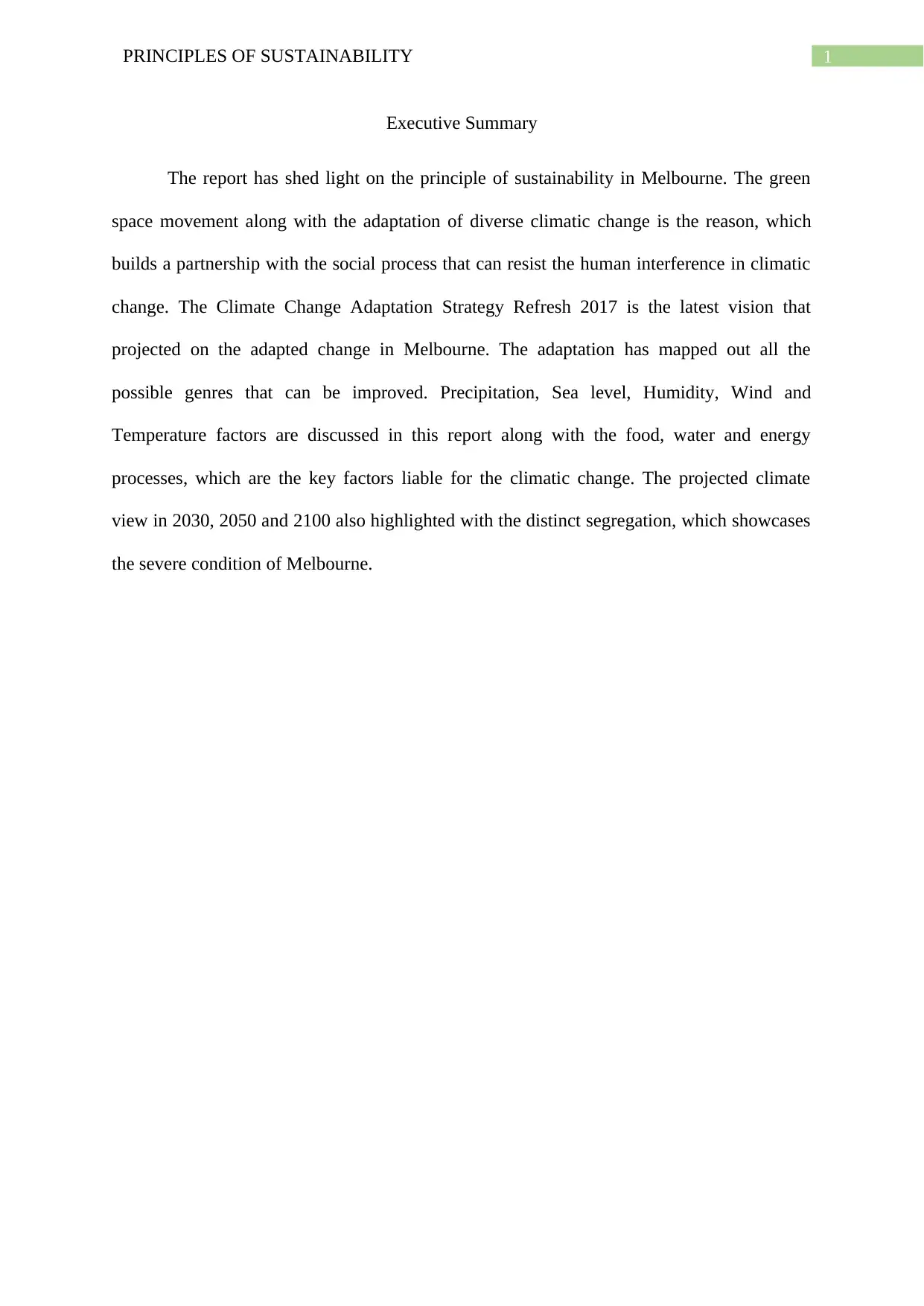
1PRINCIPLES OF SUSTAINABILITY
Executive Summary
The report has shed light on the principle of sustainability in Melbourne. The green
space movement along with the adaptation of diverse climatic change is the reason, which
builds a partnership with the social process that can resist the human interference in climatic
change. The Climate Change Adaptation Strategy Refresh 2017 is the latest vision that
projected on the adapted change in Melbourne. The adaptation has mapped out all the
possible genres that can be improved. Precipitation, Sea level, Humidity, Wind and
Temperature factors are discussed in this report along with the food, water and energy
processes, which are the key factors liable for the climatic change. The projected climate
view in 2030, 2050 and 2100 also highlighted with the distinct segregation, which showcases
the severe condition of Melbourne.
Executive Summary
The report has shed light on the principle of sustainability in Melbourne. The green
space movement along with the adaptation of diverse climatic change is the reason, which
builds a partnership with the social process that can resist the human interference in climatic
change. The Climate Change Adaptation Strategy Refresh 2017 is the latest vision that
projected on the adapted change in Melbourne. The adaptation has mapped out all the
possible genres that can be improved. Precipitation, Sea level, Humidity, Wind and
Temperature factors are discussed in this report along with the food, water and energy
processes, which are the key factors liable for the climatic change. The projected climate
view in 2030, 2050 and 2100 also highlighted with the distinct segregation, which showcases
the severe condition of Melbourne.
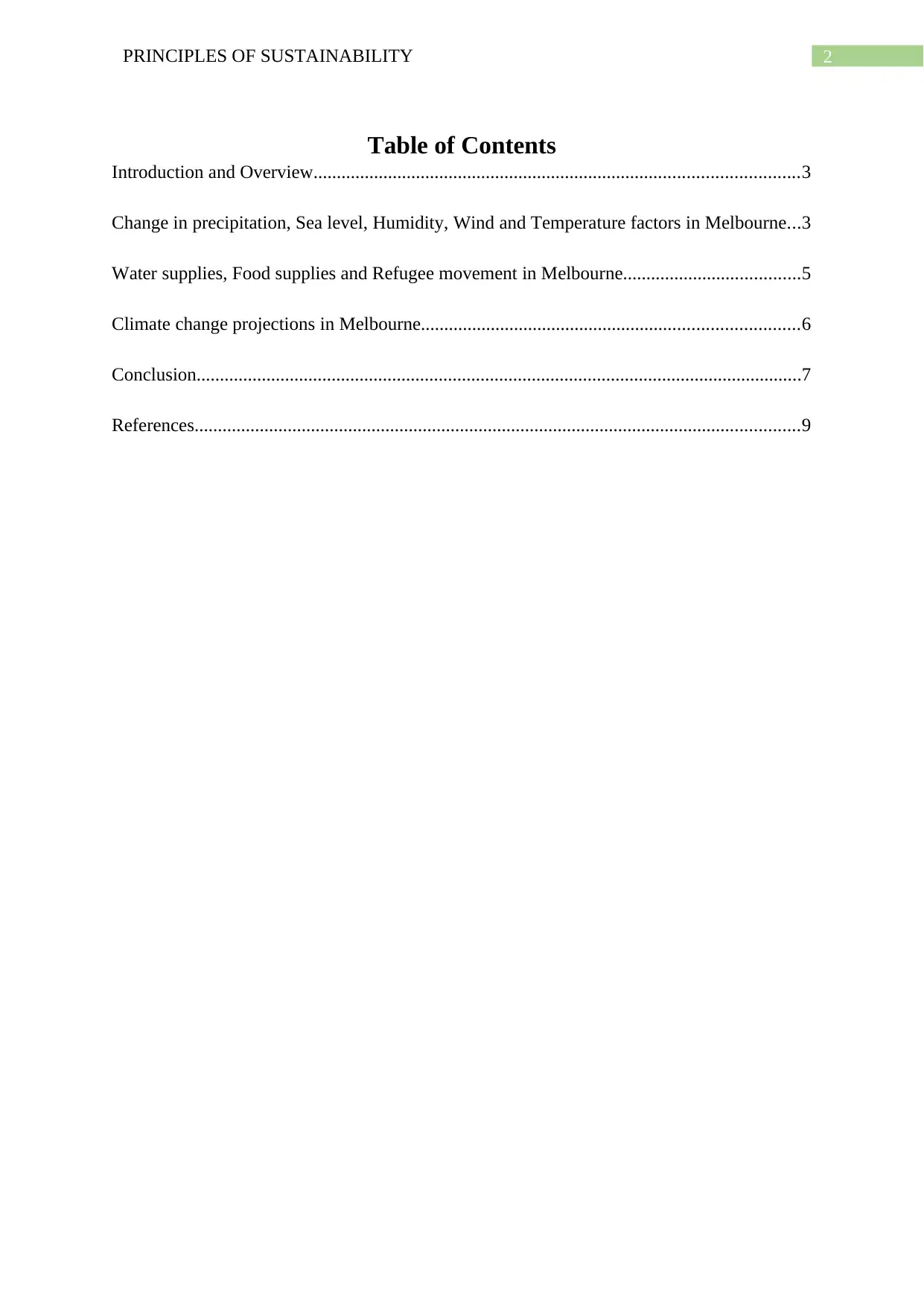
2PRINCIPLES OF SUSTAINABILITY
Table of Contents
Introduction and Overview........................................................................................................3
Change in precipitation, Sea level, Humidity, Wind and Temperature factors in Melbourne...3
Water supplies, Food supplies and Refugee movement in Melbourne......................................5
Climate change projections in Melbourne.................................................................................6
Conclusion..................................................................................................................................7
References..................................................................................................................................9
Table of Contents
Introduction and Overview........................................................................................................3
Change in precipitation, Sea level, Humidity, Wind and Temperature factors in Melbourne...3
Water supplies, Food supplies and Refugee movement in Melbourne......................................5
Climate change projections in Melbourne.................................................................................6
Conclusion..................................................................................................................................7
References..................................................................................................................................9
⊘ This is a preview!⊘
Do you want full access?
Subscribe today to unlock all pages.

Trusted by 1+ million students worldwide
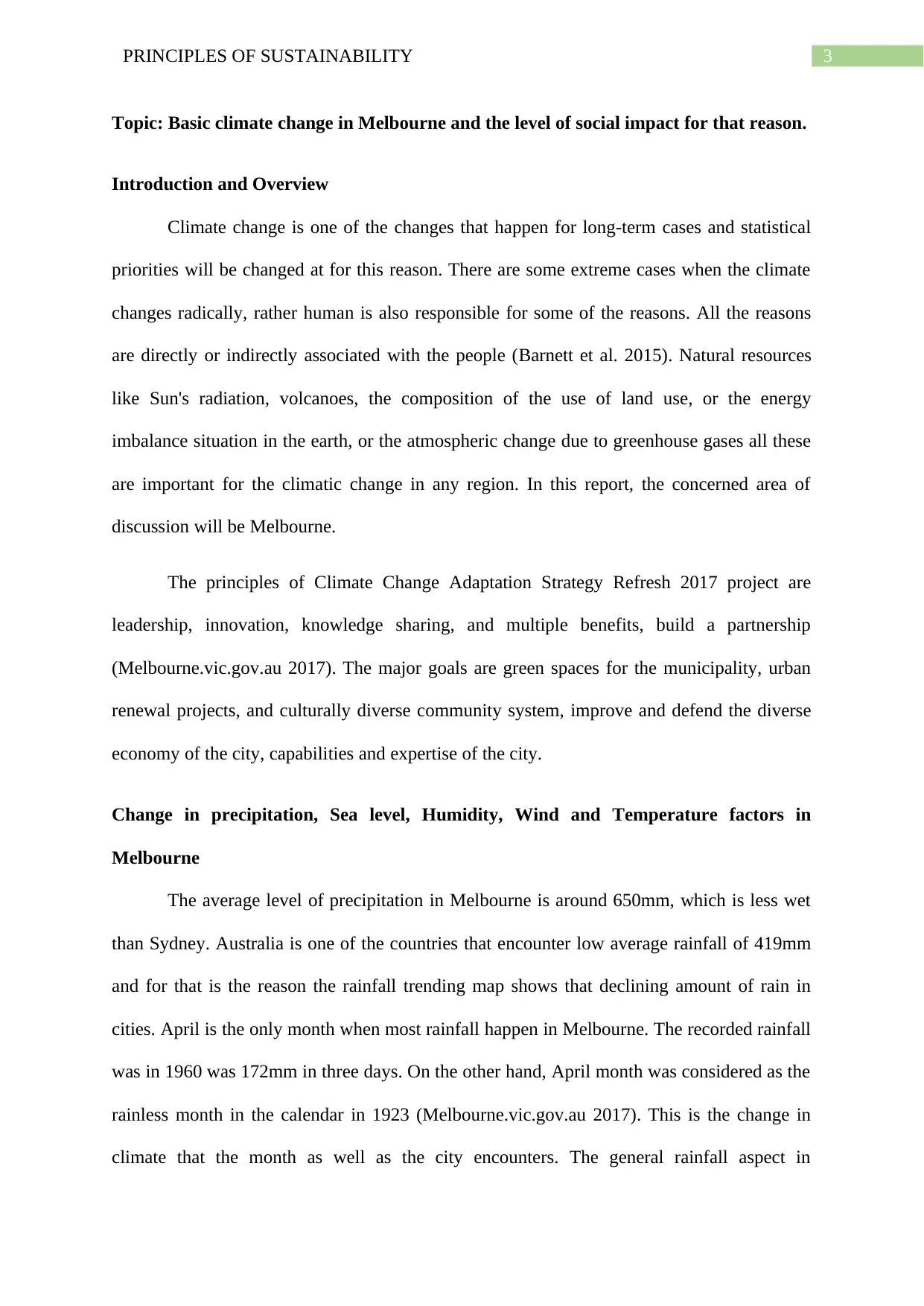
3PRINCIPLES OF SUSTAINABILITY
Topic: Basic climate change in Melbourne and the level of social impact for that reason.
Introduction and Overview
Climate change is one of the changes that happen for long-term cases and statistical
priorities will be changed at for this reason. There are some extreme cases when the climate
changes radically, rather human is also responsible for some of the reasons. All the reasons
are directly or indirectly associated with the people (Barnett et al. 2015). Natural resources
like Sun's radiation, volcanoes, the composition of the use of land use, or the energy
imbalance situation in the earth, or the atmospheric change due to greenhouse gases all these
are important for the climatic change in any region. In this report, the concerned area of
discussion will be Melbourne.
The principles of Climate Change Adaptation Strategy Refresh 2017 project are
leadership, innovation, knowledge sharing, and multiple benefits, build a partnership
(Melbourne.vic.gov.au 2017). The major goals are green spaces for the municipality, urban
renewal projects, and culturally diverse community system, improve and defend the diverse
economy of the city, capabilities and expertise of the city.
Change in precipitation, Sea level, Humidity, Wind and Temperature factors in
Melbourne
The average level of precipitation in Melbourne is around 650mm, which is less wet
than Sydney. Australia is one of the countries that encounter low average rainfall of 419mm
and for that is the reason the rainfall trending map shows that declining amount of rain in
cities. April is the only month when most rainfall happen in Melbourne. The recorded rainfall
was in 1960 was 172mm in three days. On the other hand, April month was considered as the
rainless month in the calendar in 1923 (Melbourne.vic.gov.au 2017). This is the change in
climate that the month as well as the city encounters. The general rainfall aspect in
Topic: Basic climate change in Melbourne and the level of social impact for that reason.
Introduction and Overview
Climate change is one of the changes that happen for long-term cases and statistical
priorities will be changed at for this reason. There are some extreme cases when the climate
changes radically, rather human is also responsible for some of the reasons. All the reasons
are directly or indirectly associated with the people (Barnett et al. 2015). Natural resources
like Sun's radiation, volcanoes, the composition of the use of land use, or the energy
imbalance situation in the earth, or the atmospheric change due to greenhouse gases all these
are important for the climatic change in any region. In this report, the concerned area of
discussion will be Melbourne.
The principles of Climate Change Adaptation Strategy Refresh 2017 project are
leadership, innovation, knowledge sharing, and multiple benefits, build a partnership
(Melbourne.vic.gov.au 2017). The major goals are green spaces for the municipality, urban
renewal projects, and culturally diverse community system, improve and defend the diverse
economy of the city, capabilities and expertise of the city.
Change in precipitation, Sea level, Humidity, Wind and Temperature factors in
Melbourne
The average level of precipitation in Melbourne is around 650mm, which is less wet
than Sydney. Australia is one of the countries that encounter low average rainfall of 419mm
and for that is the reason the rainfall trending map shows that declining amount of rain in
cities. April is the only month when most rainfall happen in Melbourne. The recorded rainfall
was in 1960 was 172mm in three days. On the other hand, April month was considered as the
rainless month in the calendar in 1923 (Melbourne.vic.gov.au 2017). This is the change in
climate that the month as well as the city encounters. The general rainfall aspect in
Paraphrase This Document
Need a fresh take? Get an instant paraphrase of this document with our AI Paraphraser
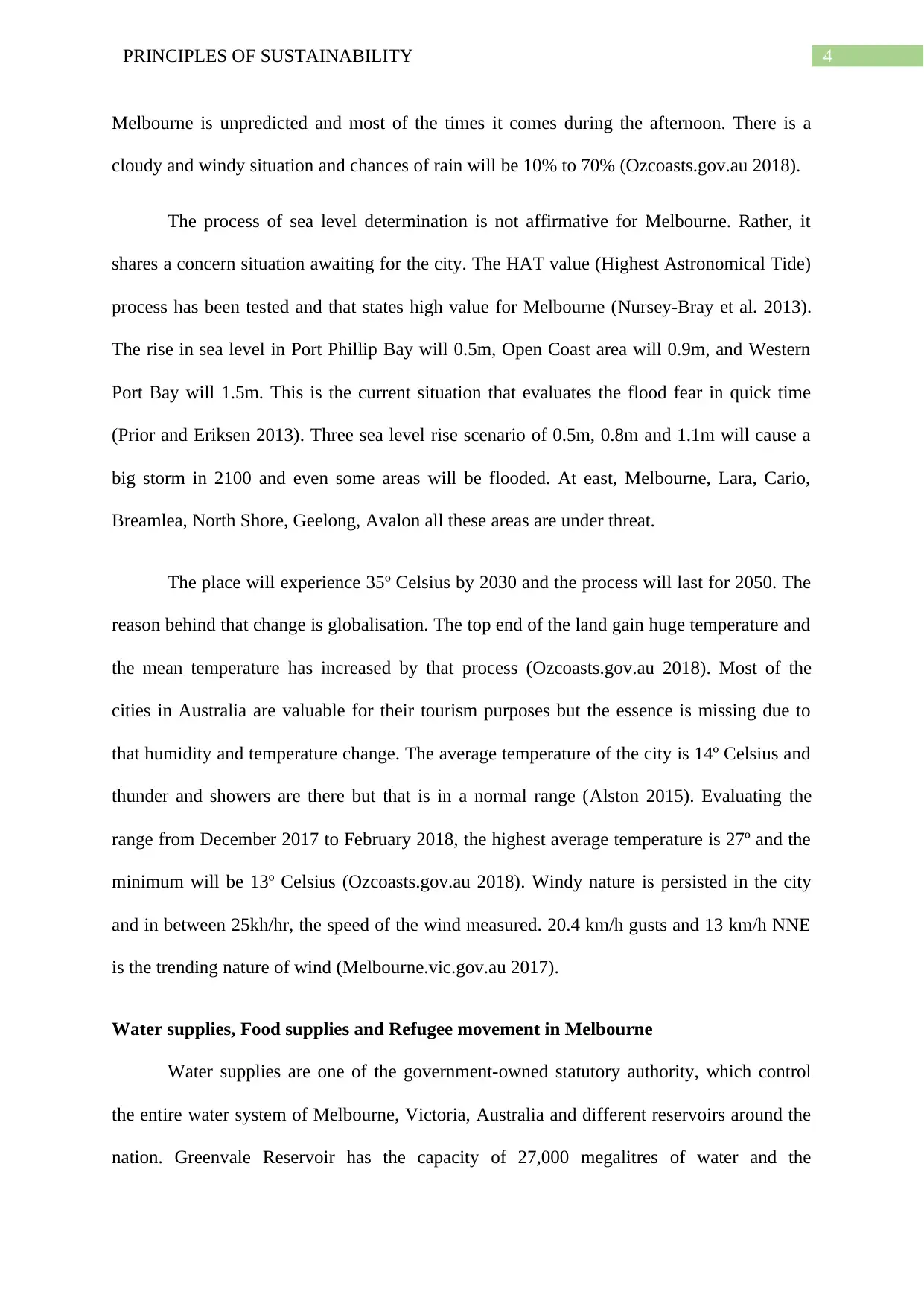
4PRINCIPLES OF SUSTAINABILITY
Melbourne is unpredicted and most of the times it comes during the afternoon. There is a
cloudy and windy situation and chances of rain will be 10% to 70% (Ozcoasts.gov.au 2018).
The process of sea level determination is not affirmative for Melbourne. Rather, it
shares a concern situation awaiting for the city. The HAT value (Highest Astronomical Tide)
process has been tested and that states high value for Melbourne (Nursey-Bray et al. 2013).
The rise in sea level in Port Phillip Bay will 0.5m, Open Coast area will 0.9m, and Western
Port Bay will 1.5m. This is the current situation that evaluates the flood fear in quick time
(Prior and Eriksen 2013). Three sea level rise scenario of 0.5m, 0.8m and 1.1m will cause a
big storm in 2100 and even some areas will be flooded. At east, Melbourne, Lara, Cario,
Breamlea, North Shore, Geelong, Avalon all these areas are under threat.
The place will experience 35º Celsius by 2030 and the process will last for 2050. The
reason behind that change is globalisation. The top end of the land gain huge temperature and
the mean temperature has increased by that process (Ozcoasts.gov.au 2018). Most of the
cities in Australia are valuable for their tourism purposes but the essence is missing due to
that humidity and temperature change. The average temperature of the city is 14º Celsius and
thunder and showers are there but that is in a normal range (Alston 2015). Evaluating the
range from December 2017 to February 2018, the highest average temperature is 27º and the
minimum will be 13º Celsius (Ozcoasts.gov.au 2018). Windy nature is persisted in the city
and in between 25kh/hr, the speed of the wind measured. 20.4 km/h gusts and 13 km/h NNE
is the trending nature of wind (Melbourne.vic.gov.au 2017).
Water supplies, Food supplies and Refugee movement in Melbourne
Water supplies are one of the government-owned statutory authority, which control
the entire water system of Melbourne, Victoria, Australia and different reservoirs around the
nation. Greenvale Reservoir has the capacity of 27,000 megalitres of water and the
Melbourne is unpredicted and most of the times it comes during the afternoon. There is a
cloudy and windy situation and chances of rain will be 10% to 70% (Ozcoasts.gov.au 2018).
The process of sea level determination is not affirmative for Melbourne. Rather, it
shares a concern situation awaiting for the city. The HAT value (Highest Astronomical Tide)
process has been tested and that states high value for Melbourne (Nursey-Bray et al. 2013).
The rise in sea level in Port Phillip Bay will 0.5m, Open Coast area will 0.9m, and Western
Port Bay will 1.5m. This is the current situation that evaluates the flood fear in quick time
(Prior and Eriksen 2013). Three sea level rise scenario of 0.5m, 0.8m and 1.1m will cause a
big storm in 2100 and even some areas will be flooded. At east, Melbourne, Lara, Cario,
Breamlea, North Shore, Geelong, Avalon all these areas are under threat.
The place will experience 35º Celsius by 2030 and the process will last for 2050. The
reason behind that change is globalisation. The top end of the land gain huge temperature and
the mean temperature has increased by that process (Ozcoasts.gov.au 2018). Most of the
cities in Australia are valuable for their tourism purposes but the essence is missing due to
that humidity and temperature change. The average temperature of the city is 14º Celsius and
thunder and showers are there but that is in a normal range (Alston 2015). Evaluating the
range from December 2017 to February 2018, the highest average temperature is 27º and the
minimum will be 13º Celsius (Ozcoasts.gov.au 2018). Windy nature is persisted in the city
and in between 25kh/hr, the speed of the wind measured. 20.4 km/h gusts and 13 km/h NNE
is the trending nature of wind (Melbourne.vic.gov.au 2017).
Water supplies, Food supplies and Refugee movement in Melbourne
Water supplies are one of the government-owned statutory authority, which control
the entire water system of Melbourne, Victoria, Australia and different reservoirs around the
nation. Greenvale Reservoir has the capacity of 27,000 megalitres of water and the
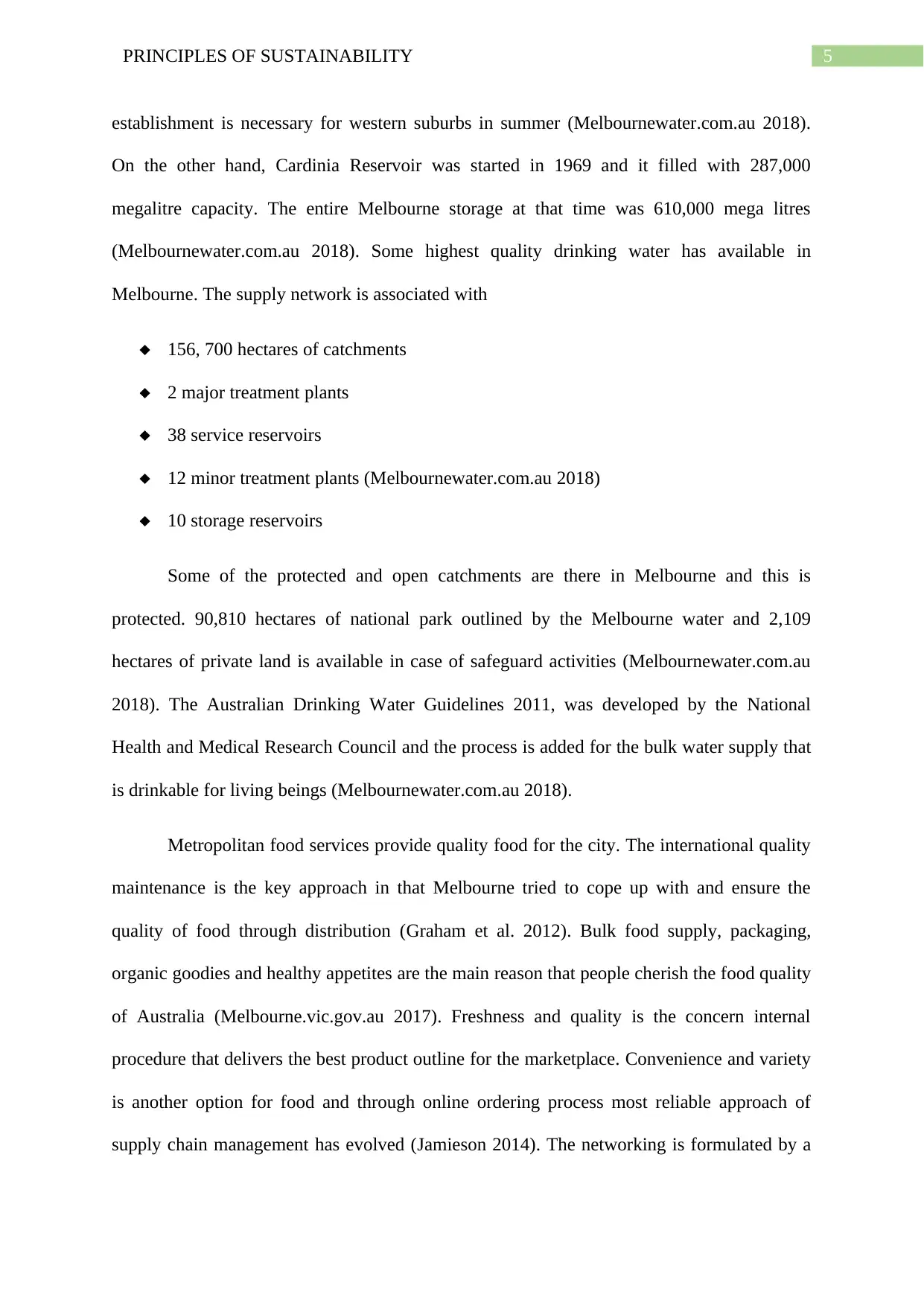
5PRINCIPLES OF SUSTAINABILITY
establishment is necessary for western suburbs in summer (Melbournewater.com.au 2018).
On the other hand, Cardinia Reservoir was started in 1969 and it filled with 287,000
megalitre capacity. The entire Melbourne storage at that time was 610,000 mega litres
(Melbournewater.com.au 2018). Some highest quality drinking water has available in
Melbourne. The supply network is associated with
156, 700 hectares of catchments
2 major treatment plants
38 service reservoirs
12 minor treatment plants (Melbournewater.com.au 2018)
10 storage reservoirs
Some of the protected and open catchments are there in Melbourne and this is
protected. 90,810 hectares of national park outlined by the Melbourne water and 2,109
hectares of private land is available in case of safeguard activities (Melbournewater.com.au
2018). The Australian Drinking Water Guidelines 2011, was developed by the National
Health and Medical Research Council and the process is added for the bulk water supply that
is drinkable for living beings (Melbournewater.com.au 2018).
Metropolitan food services provide quality food for the city. The international quality
maintenance is the key approach in that Melbourne tried to cope up with and ensure the
quality of food through distribution (Graham et al. 2012). Bulk food supply, packaging,
organic goodies and healthy appetites are the main reason that people cherish the food quality
of Australia (Melbourne.vic.gov.au 2017). Freshness and quality is the concern internal
procedure that delivers the best product outline for the marketplace. Convenience and variety
is another option for food and through online ordering process most reliable approach of
supply chain management has evolved (Jamieson 2014). The networking is formulated by a
establishment is necessary for western suburbs in summer (Melbournewater.com.au 2018).
On the other hand, Cardinia Reservoir was started in 1969 and it filled with 287,000
megalitre capacity. The entire Melbourne storage at that time was 610,000 mega litres
(Melbournewater.com.au 2018). Some highest quality drinking water has available in
Melbourne. The supply network is associated with
156, 700 hectares of catchments
2 major treatment plants
38 service reservoirs
12 minor treatment plants (Melbournewater.com.au 2018)
10 storage reservoirs
Some of the protected and open catchments are there in Melbourne and this is
protected. 90,810 hectares of national park outlined by the Melbourne water and 2,109
hectares of private land is available in case of safeguard activities (Melbournewater.com.au
2018). The Australian Drinking Water Guidelines 2011, was developed by the National
Health and Medical Research Council and the process is added for the bulk water supply that
is drinkable for living beings (Melbournewater.com.au 2018).
Metropolitan food services provide quality food for the city. The international quality
maintenance is the key approach in that Melbourne tried to cope up with and ensure the
quality of food through distribution (Graham et al. 2012). Bulk food supply, packaging,
organic goodies and healthy appetites are the main reason that people cherish the food quality
of Australia (Melbourne.vic.gov.au 2017). Freshness and quality is the concern internal
procedure that delivers the best product outline for the marketplace. Convenience and variety
is another option for food and through online ordering process most reliable approach of
supply chain management has evolved (Jamieson 2014). The networking is formulated by a
⊘ This is a preview!⊘
Do you want full access?
Subscribe today to unlock all pages.

Trusted by 1+ million students worldwide
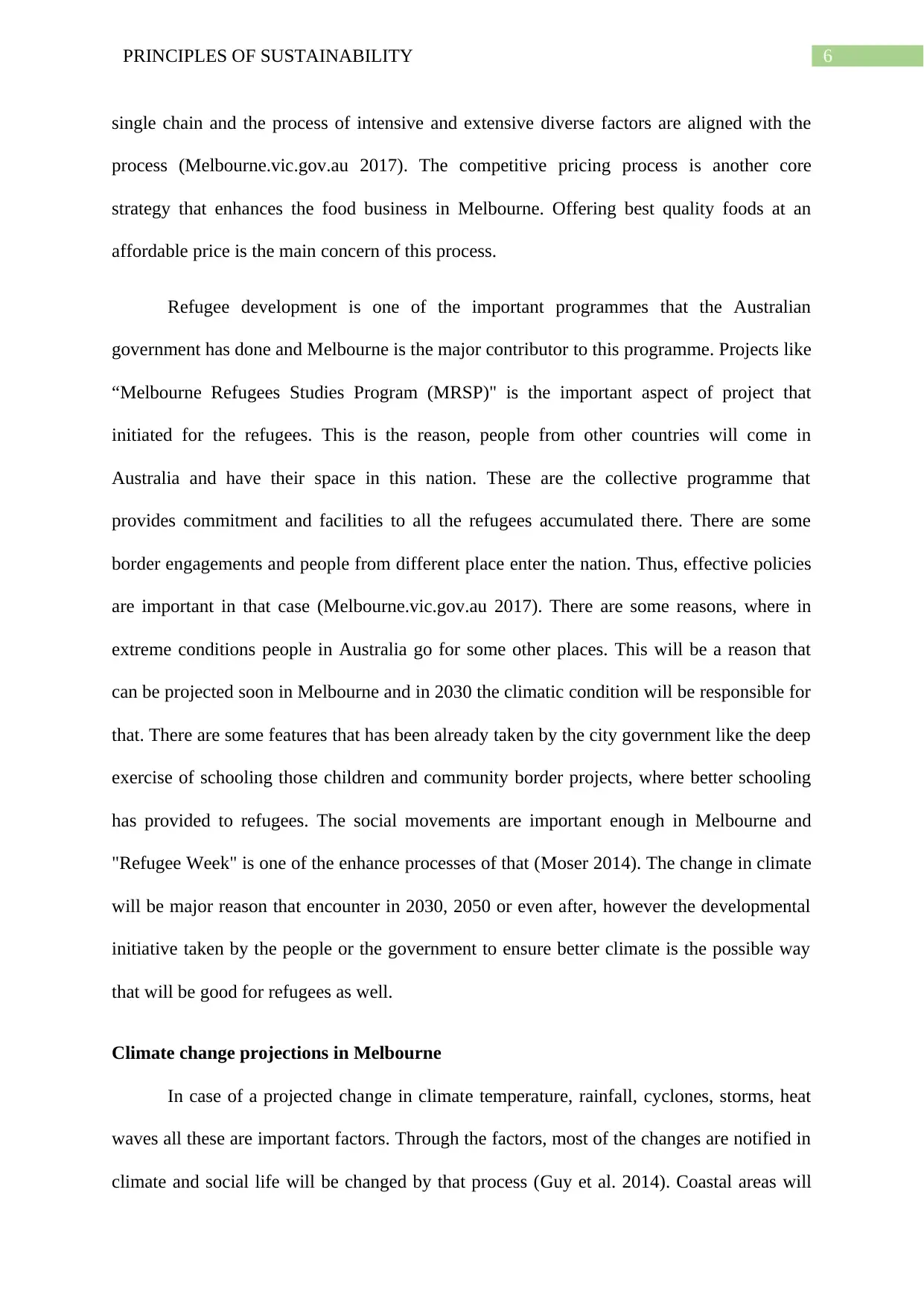
6PRINCIPLES OF SUSTAINABILITY
single chain and the process of intensive and extensive diverse factors are aligned with the
process (Melbourne.vic.gov.au 2017). The competitive pricing process is another core
strategy that enhances the food business in Melbourne. Offering best quality foods at an
affordable price is the main concern of this process.
Refugee development is one of the important programmes that the Australian
government has done and Melbourne is the major contributor to this programme. Projects like
“Melbourne Refugees Studies Program (MRSP)" is the important aspect of project that
initiated for the refugees. This is the reason, people from other countries will come in
Australia and have their space in this nation. These are the collective programme that
provides commitment and facilities to all the refugees accumulated there. There are some
border engagements and people from different place enter the nation. Thus, effective policies
are important in that case (Melbourne.vic.gov.au 2017). There are some reasons, where in
extreme conditions people in Australia go for some other places. This will be a reason that
can be projected soon in Melbourne and in 2030 the climatic condition will be responsible for
that. There are some features that has been already taken by the city government like the deep
exercise of schooling those children and community border projects, where better schooling
has provided to refugees. The social movements are important enough in Melbourne and
"Refugee Week" is one of the enhance processes of that (Moser 2014). The change in climate
will be major reason that encounter in 2030, 2050 or even after, however the developmental
initiative taken by the people or the government to ensure better climate is the possible way
that will be good for refugees as well.
Climate change projections in Melbourne
In case of a projected change in climate temperature, rainfall, cyclones, storms, heat
waves all these are important factors. Through the factors, most of the changes are notified in
climate and social life will be changed by that process (Guy et al. 2014). Coastal areas will
single chain and the process of intensive and extensive diverse factors are aligned with the
process (Melbourne.vic.gov.au 2017). The competitive pricing process is another core
strategy that enhances the food business in Melbourne. Offering best quality foods at an
affordable price is the main concern of this process.
Refugee development is one of the important programmes that the Australian
government has done and Melbourne is the major contributor to this programme. Projects like
“Melbourne Refugees Studies Program (MRSP)" is the important aspect of project that
initiated for the refugees. This is the reason, people from other countries will come in
Australia and have their space in this nation. These are the collective programme that
provides commitment and facilities to all the refugees accumulated there. There are some
border engagements and people from different place enter the nation. Thus, effective policies
are important in that case (Melbourne.vic.gov.au 2017). There are some reasons, where in
extreme conditions people in Australia go for some other places. This will be a reason that
can be projected soon in Melbourne and in 2030 the climatic condition will be responsible for
that. There are some features that has been already taken by the city government like the deep
exercise of schooling those children and community border projects, where better schooling
has provided to refugees. The social movements are important enough in Melbourne and
"Refugee Week" is one of the enhance processes of that (Moser 2014). The change in climate
will be major reason that encounter in 2030, 2050 or even after, however the developmental
initiative taken by the people or the government to ensure better climate is the possible way
that will be good for refugees as well.
Climate change projections in Melbourne
In case of a projected change in climate temperature, rainfall, cyclones, storms, heat
waves all these are important factors. Through the factors, most of the changes are notified in
climate and social life will be changed by that process (Guy et al. 2014). Coastal areas will
Paraphrase This Document
Need a fresh take? Get an instant paraphrase of this document with our AI Paraphraser
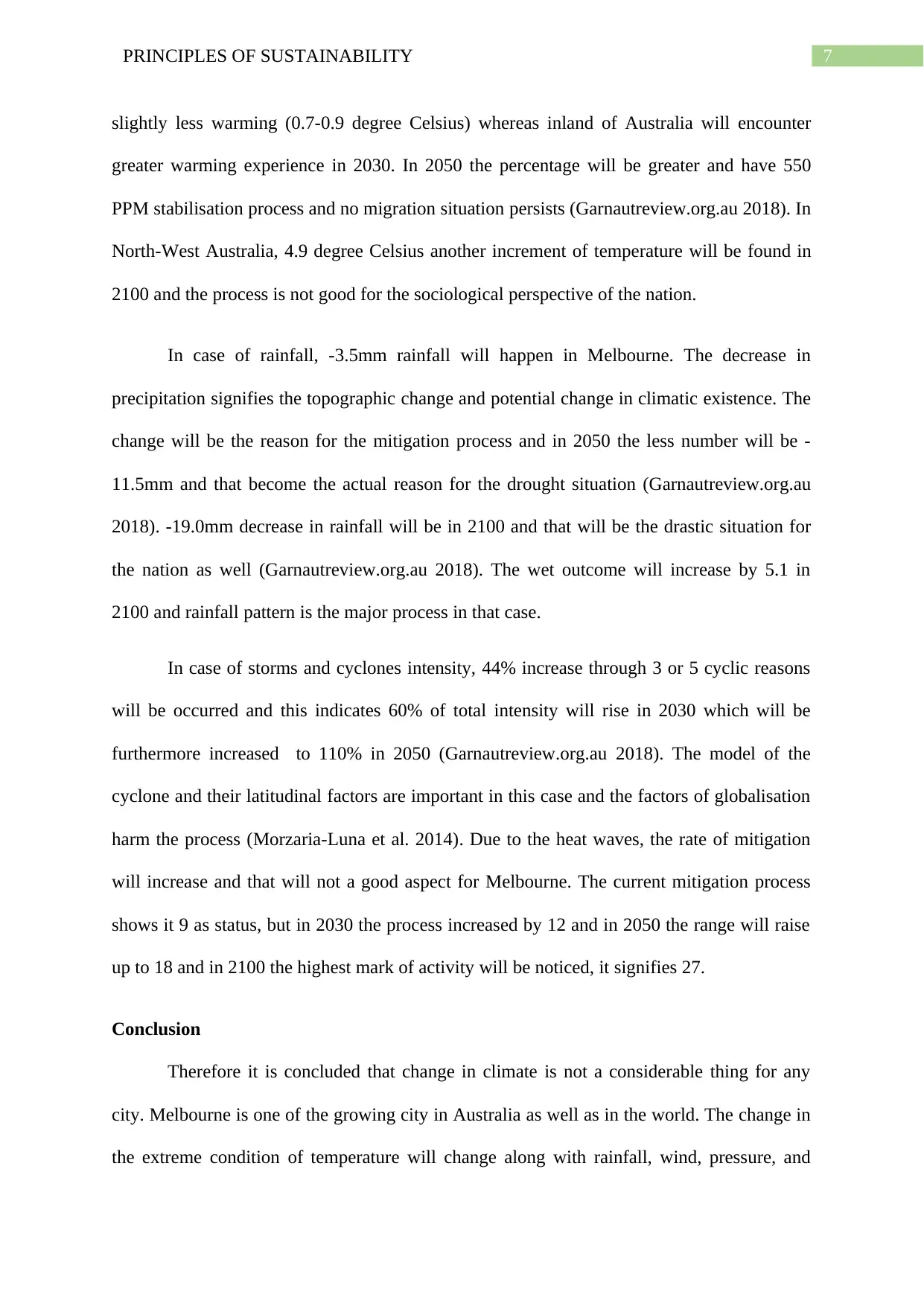
7PRINCIPLES OF SUSTAINABILITY
slightly less warming (0.7-0.9 degree Celsius) whereas inland of Australia will encounter
greater warming experience in 2030. In 2050 the percentage will be greater and have 550
PPM stabilisation process and no migration situation persists (Garnautreview.org.au 2018). In
North-West Australia, 4.9 degree Celsius another increment of temperature will be found in
2100 and the process is not good for the sociological perspective of the nation.
In case of rainfall, -3.5mm rainfall will happen in Melbourne. The decrease in
precipitation signifies the topographic change and potential change in climatic existence. The
change will be the reason for the mitigation process and in 2050 the less number will be -
11.5mm and that become the actual reason for the drought situation (Garnautreview.org.au
2018). -19.0mm decrease in rainfall will be in 2100 and that will be the drastic situation for
the nation as well (Garnautreview.org.au 2018). The wet outcome will increase by 5.1 in
2100 and rainfall pattern is the major process in that case.
In case of storms and cyclones intensity, 44% increase through 3 or 5 cyclic reasons
will be occurred and this indicates 60% of total intensity will rise in 2030 which will be
furthermore increased to 110% in 2050 (Garnautreview.org.au 2018). The model of the
cyclone and their latitudinal factors are important in this case and the factors of globalisation
harm the process (Morzaria-Luna et al. 2014). Due to the heat waves, the rate of mitigation
will increase and that will not a good aspect for Melbourne. The current mitigation process
shows it 9 as status, but in 2030 the process increased by 12 and in 2050 the range will raise
up to 18 and in 2100 the highest mark of activity will be noticed, it signifies 27.
Conclusion
Therefore it is concluded that change in climate is not a considerable thing for any
city. Melbourne is one of the growing city in Australia as well as in the world. The change in
the extreme condition of temperature will change along with rainfall, wind, pressure, and
slightly less warming (0.7-0.9 degree Celsius) whereas inland of Australia will encounter
greater warming experience in 2030. In 2050 the percentage will be greater and have 550
PPM stabilisation process and no migration situation persists (Garnautreview.org.au 2018). In
North-West Australia, 4.9 degree Celsius another increment of temperature will be found in
2100 and the process is not good for the sociological perspective of the nation.
In case of rainfall, -3.5mm rainfall will happen in Melbourne. The decrease in
precipitation signifies the topographic change and potential change in climatic existence. The
change will be the reason for the mitigation process and in 2050 the less number will be -
11.5mm and that become the actual reason for the drought situation (Garnautreview.org.au
2018). -19.0mm decrease in rainfall will be in 2100 and that will be the drastic situation for
the nation as well (Garnautreview.org.au 2018). The wet outcome will increase by 5.1 in
2100 and rainfall pattern is the major process in that case.
In case of storms and cyclones intensity, 44% increase through 3 or 5 cyclic reasons
will be occurred and this indicates 60% of total intensity will rise in 2030 which will be
furthermore increased to 110% in 2050 (Garnautreview.org.au 2018). The model of the
cyclone and their latitudinal factors are important in this case and the factors of globalisation
harm the process (Morzaria-Luna et al. 2014). Due to the heat waves, the rate of mitigation
will increase and that will not a good aspect for Melbourne. The current mitigation process
shows it 9 as status, but in 2030 the process increased by 12 and in 2050 the range will raise
up to 18 and in 2100 the highest mark of activity will be noticed, it signifies 27.
Conclusion
Therefore it is concluded that change in climate is not a considerable thing for any
city. Melbourne is one of the growing city in Australia as well as in the world. The change in
the extreme condition of temperature will change along with rainfall, wind, pressure, and
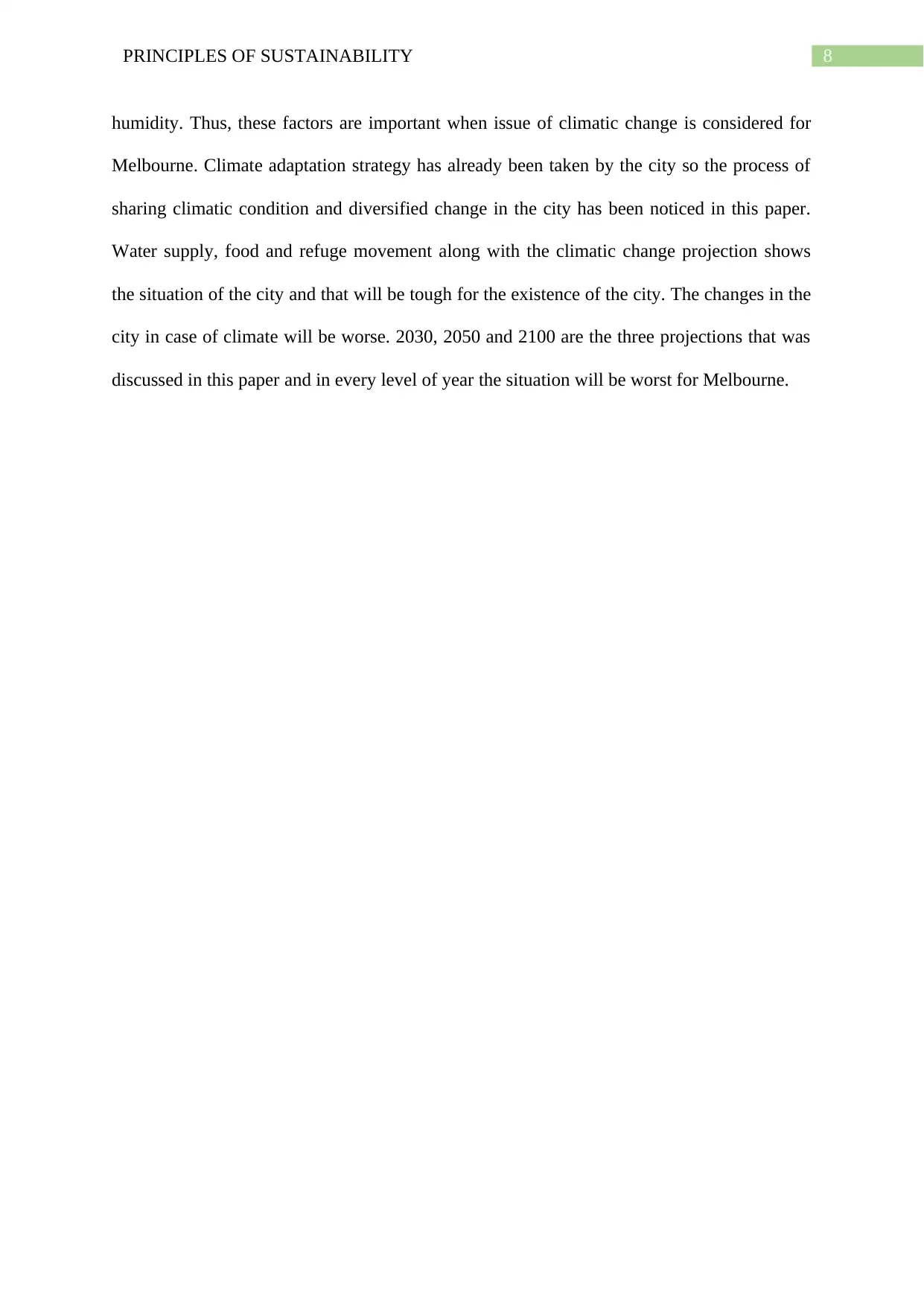
8PRINCIPLES OF SUSTAINABILITY
humidity. Thus, these factors are important when issue of climatic change is considered for
Melbourne. Climate adaptation strategy has already been taken by the city so the process of
sharing climatic condition and diversified change in the city has been noticed in this paper.
Water supply, food and refuge movement along with the climatic change projection shows
the situation of the city and that will be tough for the existence of the city. The changes in the
city in case of climate will be worse. 2030, 2050 and 2100 are the three projections that was
discussed in this paper and in every level of year the situation will be worst for Melbourne.
humidity. Thus, these factors are important when issue of climatic change is considered for
Melbourne. Climate adaptation strategy has already been taken by the city so the process of
sharing climatic condition and diversified change in the city has been noticed in this paper.
Water supply, food and refuge movement along with the climatic change projection shows
the situation of the city and that will be tough for the existence of the city. The changes in the
city in case of climate will be worse. 2030, 2050 and 2100 are the three projections that was
discussed in this paper and in every level of year the situation will be worst for Melbourne.
⊘ This is a preview!⊘
Do you want full access?
Subscribe today to unlock all pages.

Trusted by 1+ million students worldwide
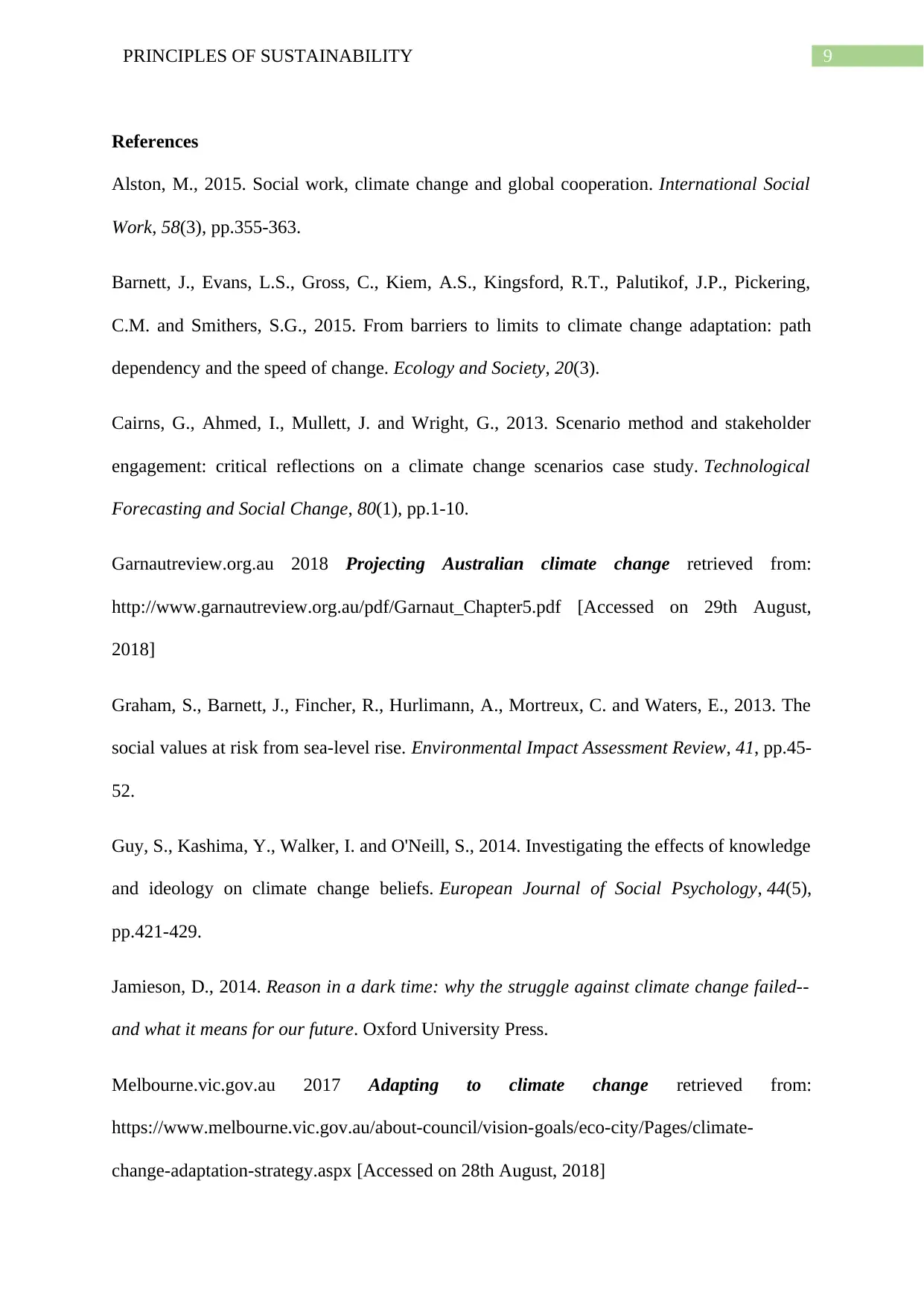
9PRINCIPLES OF SUSTAINABILITY
References
Alston, M., 2015. Social work, climate change and global cooperation. International Social
Work, 58(3), pp.355-363.
Barnett, J., Evans, L.S., Gross, C., Kiem, A.S., Kingsford, R.T., Palutikof, J.P., Pickering,
C.M. and Smithers, S.G., 2015. From barriers to limits to climate change adaptation: path
dependency and the speed of change. Ecology and Society, 20(3).
Cairns, G., Ahmed, I., Mullett, J. and Wright, G., 2013. Scenario method and stakeholder
engagement: critical reflections on a climate change scenarios case study. Technological
Forecasting and Social Change, 80(1), pp.1-10.
Garnautreview.org.au 2018 Projecting Australian climate change retrieved from:
http://www.garnautreview.org.au/pdf/Garnaut_Chapter5.pdf [Accessed on 29th August,
2018]
Graham, S., Barnett, J., Fincher, R., Hurlimann, A., Mortreux, C. and Waters, E., 2013. The
social values at risk from sea-level rise. Environmental Impact Assessment Review, 41, pp.45-
52.
Guy, S., Kashima, Y., Walker, I. and O'Neill, S., 2014. Investigating the effects of knowledge
and ideology on climate change beliefs. European Journal of Social Psychology, 44(5),
pp.421-429.
Jamieson, D., 2014. Reason in a dark time: why the struggle against climate change failed--
and what it means for our future. Oxford University Press.
Melbourne.vic.gov.au 2017 Adapting to climate change retrieved from:
https://www.melbourne.vic.gov.au/about-council/vision-goals/eco-city/Pages/climate-
change-adaptation-strategy.aspx [Accessed on 28th August, 2018]
References
Alston, M., 2015. Social work, climate change and global cooperation. International Social
Work, 58(3), pp.355-363.
Barnett, J., Evans, L.S., Gross, C., Kiem, A.S., Kingsford, R.T., Palutikof, J.P., Pickering,
C.M. and Smithers, S.G., 2015. From barriers to limits to climate change adaptation: path
dependency and the speed of change. Ecology and Society, 20(3).
Cairns, G., Ahmed, I., Mullett, J. and Wright, G., 2013. Scenario method and stakeholder
engagement: critical reflections on a climate change scenarios case study. Technological
Forecasting and Social Change, 80(1), pp.1-10.
Garnautreview.org.au 2018 Projecting Australian climate change retrieved from:
http://www.garnautreview.org.au/pdf/Garnaut_Chapter5.pdf [Accessed on 29th August,
2018]
Graham, S., Barnett, J., Fincher, R., Hurlimann, A., Mortreux, C. and Waters, E., 2013. The
social values at risk from sea-level rise. Environmental Impact Assessment Review, 41, pp.45-
52.
Guy, S., Kashima, Y., Walker, I. and O'Neill, S., 2014. Investigating the effects of knowledge
and ideology on climate change beliefs. European Journal of Social Psychology, 44(5),
pp.421-429.
Jamieson, D., 2014. Reason in a dark time: why the struggle against climate change failed--
and what it means for our future. Oxford University Press.
Melbourne.vic.gov.au 2017 Adapting to climate change retrieved from:
https://www.melbourne.vic.gov.au/about-council/vision-goals/eco-city/Pages/climate-
change-adaptation-strategy.aspx [Accessed on 28th August, 2018]
Paraphrase This Document
Need a fresh take? Get an instant paraphrase of this document with our AI Paraphraser
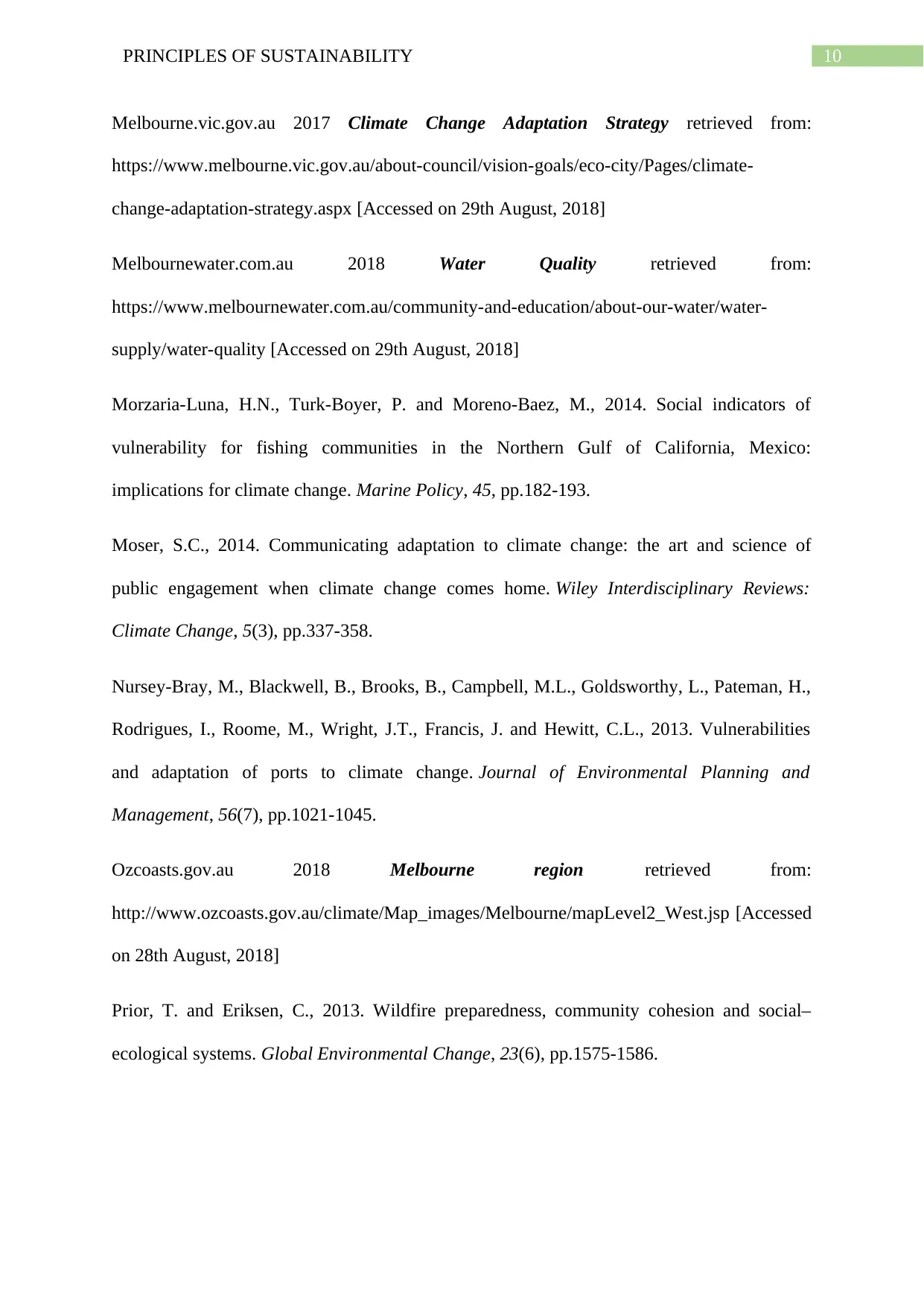
10PRINCIPLES OF SUSTAINABILITY
Melbourne.vic.gov.au 2017 Climate Change Adaptation Strategy retrieved from:
https://www.melbourne.vic.gov.au/about-council/vision-goals/eco-city/Pages/climate-
change-adaptation-strategy.aspx [Accessed on 29th August, 2018]
Melbournewater.com.au 2018 Water Quality retrieved from:
https://www.melbournewater.com.au/community-and-education/about-our-water/water-
supply/water-quality [Accessed on 29th August, 2018]
Morzaria-Luna, H.N., Turk-Boyer, P. and Moreno-Baez, M., 2014. Social indicators of
vulnerability for fishing communities in the Northern Gulf of California, Mexico:
implications for climate change. Marine Policy, 45, pp.182-193.
Moser, S.C., 2014. Communicating adaptation to climate change: the art and science of
public engagement when climate change comes home. Wiley Interdisciplinary Reviews:
Climate Change, 5(3), pp.337-358.
Nursey-Bray, M., Blackwell, B., Brooks, B., Campbell, M.L., Goldsworthy, L., Pateman, H.,
Rodrigues, I., Roome, M., Wright, J.T., Francis, J. and Hewitt, C.L., 2013. Vulnerabilities
and adaptation of ports to climate change. Journal of Environmental Planning and
Management, 56(7), pp.1021-1045.
Ozcoasts.gov.au 2018 Melbourne region retrieved from:
http://www.ozcoasts.gov.au/climate/Map_images/Melbourne/mapLevel2_West.jsp [Accessed
on 28th August, 2018]
Prior, T. and Eriksen, C., 2013. Wildfire preparedness, community cohesion and social–
ecological systems. Global Environmental Change, 23(6), pp.1575-1586.
Melbourne.vic.gov.au 2017 Climate Change Adaptation Strategy retrieved from:
https://www.melbourne.vic.gov.au/about-council/vision-goals/eco-city/Pages/climate-
change-adaptation-strategy.aspx [Accessed on 29th August, 2018]
Melbournewater.com.au 2018 Water Quality retrieved from:
https://www.melbournewater.com.au/community-and-education/about-our-water/water-
supply/water-quality [Accessed on 29th August, 2018]
Morzaria-Luna, H.N., Turk-Boyer, P. and Moreno-Baez, M., 2014. Social indicators of
vulnerability for fishing communities in the Northern Gulf of California, Mexico:
implications for climate change. Marine Policy, 45, pp.182-193.
Moser, S.C., 2014. Communicating adaptation to climate change: the art and science of
public engagement when climate change comes home. Wiley Interdisciplinary Reviews:
Climate Change, 5(3), pp.337-358.
Nursey-Bray, M., Blackwell, B., Brooks, B., Campbell, M.L., Goldsworthy, L., Pateman, H.,
Rodrigues, I., Roome, M., Wright, J.T., Francis, J. and Hewitt, C.L., 2013. Vulnerabilities
and adaptation of ports to climate change. Journal of Environmental Planning and
Management, 56(7), pp.1021-1045.
Ozcoasts.gov.au 2018 Melbourne region retrieved from:
http://www.ozcoasts.gov.au/climate/Map_images/Melbourne/mapLevel2_West.jsp [Accessed
on 28th August, 2018]
Prior, T. and Eriksen, C., 2013. Wildfire preparedness, community cohesion and social–
ecological systems. Global Environmental Change, 23(6), pp.1575-1586.
1 out of 11
Related Documents
Your All-in-One AI-Powered Toolkit for Academic Success.
+13062052269
info@desklib.com
Available 24*7 on WhatsApp / Email
![[object Object]](/_next/static/media/star-bottom.7253800d.svg)
Unlock your academic potential
Copyright © 2020–2025 A2Z Services. All Rights Reserved. Developed and managed by ZUCOL.





